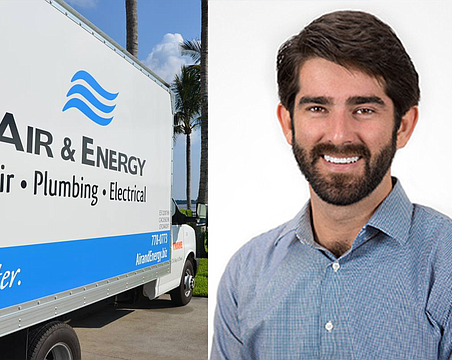Regional Expansion
banking by Jean Gruss | Editor/Lee-Collier
Regions Financial is focused on merging with AmSouth Bancorporation, but expect the bank to grow aggressively in Southwest Florida when that's done.
At an analyst conference organized by Citigroup Jan. 30, Regions Financial Corp. executives showed a PowerPoint slide of Florida that read: "Strong Florida Presence."
On another slide, the Alabama-based banking company listed as its top strategy to grow deposit market share in Florida. It's easy to understand why: The state's population is still booming even as the residential market slows.
Regions' presence in Florida became a lot stronger when it acquired rival Birmingham-based AmSouth Bancorporation in November, creating a bank with $139 billion in assets. For example, Regions got a foothold in the competitive Naples area by gaining AmSouth's 6.6% deposit market share there, leaping into fifth place, according to the most recent data from the Federal Deposit Insurance Corp. (FDIC).
In the Tampa Bay area, Regions' market share was less than 1% last year while AmSouth's was 7.66%. Now Regions is in fourth place for deposit market share, behind Bank of America, Wachovia and SunTrust.
Regions also holds an ace that few of its local or regional competitors have: an investment banking, brokerage and trust company called Morgan Keegan, which manages $76 billion in assets.
While its executives are busy with the AmSouth merger now, expect Regions to make a renewed push to open new branches after this summer. In Southwest Florida, a dozen sites are pending or under contract in the next six months.
"Florida is where we're spending capital on bricks and mortar," says Danny Morgan, Region's Southwest Florida area executive. It costs about $3.5 million to $4.5 million to build a new branch, depending on land costs. The bank has a chest of $80 million in capital for new branches in Southwest Florida in the coming year, he says.
AmSouth boost
Regions began its expansion into the Florida Panhandle in the early 1990s and it has since spread to other parts of the state. The bank now has the fourth-largest deposit market share in the state, with more than $18 billion in 400 branches. Combined, West and Southwest Florida have $6 billion in deposits.
In 2000, Regions had 18 branches from Bradenton to Naples, counting the AmSouth branches. Now, it has 55. Last year it opened 13 new branches and five more are scheduled to open in the first half of this year.
Regions is slowing its new-branch growth in the first half of this year so that it can concentrate on the AmSouth merger. Because Regions' presence hasn't been strong in Southwest Florida, it is closing just four overlapping offices in Sarasota as part of the merger.
"No one loses their jobs," says Morgan, noting that finding qualified employees is so tough that it doesn't make sense to lay anyone off.
Regions got good marks for its previous acquisition, Union Planters Corp. of Memphis, Tenn., in 2004, and it plans to replicate that feat with AmSouth.
The key, Morgan says, is to integrate the two companies' best back-office systems and focus on retaining existing customers through the integration. "We want to see how the merger gets digested," Morgan says.
The Morgan Keegan edge
The principal way banks make money is by lending money at interest rates higher than those they pay depositors and pocketing the spread. But in the last year banks have had to pay depositors more because short-term interest rates have risen and strong competition combined with low long-term interest rates have kept lending rates relatively low. The result is that banks don't make as much money on lending as they did.
To keep growing, banks have looked for ways to diversify into businesses such as investment banking and brokerages that aren't as sensitive to swings in interest rates.
By most accounts, Regions has successfully done that because non-interest income was 37% of total revenue in 2006. Its ace: Morgan Keegan, its investment banking and brokerage subsidiary, contributed $1 billion in revenues in 2006, up 23% over the prior year.
Morgan Keegan has 1,200 financial advisors spread among 325 offices throughout the South and managed $76 billion in assets by the end of 2006, up 36% from 2005 (including $7 billion from the AmSouth merger). In Florida, Morgan Keegan is the state's largest bond underwriter.
Morgan Keegan has offices in Naples and Sarasota. Regions' Morgan hints that the brokerage firm may open an office in Fort Myers. Regions' increased presence in Southwest Florida may justify another Morgan Keegan office, he says. "We open up a whole new world of clients for them," Morgan says.
For Regions, owning a brokerage firm gives it an advantage over smaller local and larger regional banks that don't offer brokerage and investment banking services, particularly with coveted high-net-worth and business clients.
Diversified loan portfolio
Despite its increased presence in Florida, Regions has managed to keep its construction loans from swelling. As of Dec. 31, real estate construction loans were $14.1 billion, or 15%, of Regions' total loan portfolio.
Because of the residential real estate downturn, the historically low loss rates on construction loans may not last. For 2007, Regions executives say they expect losses on construction loans to be higher than in recent years.
The largest part of Region's loan business is the bank's real estate mortgage division, which at $38.6 billion represents 39% of the loan portfolio. With the residential downturn, that percentage is likely to shrink. "It has had an impact on lending," Morgan acknowledges.
However, Morgan says the continuing influx of new residents will likely continue to boost demand for mortgages. He estimates the soft residential real estate market will continue another six to nine months and then return to a more normal pace akin to the mid- to late-1990s.
In addition to the traditional migration of new residents from Midwest states, Morgan says the bank is seeing more people who are seeking to escape from the more crowded east coast of Florida. In particular, he says he has seen more people of Caribbean, Puerto Rican and Cuban descent in markets such as Cape Coral. What's more, there is a growing Brazilian population in Lee County.
Still, there is pressure to diversify the loan portfolio. Regions' commercial-loan portfolio is a sizeable $24.1 billion, or about 25% of total loans. However, the bank made just 13% of those loans to Florida businesses.
"We're not reducing our effort on real estate, but adding commercial and industrial," Morgan says. In Lee County, he's hired three commercial lenders in the last month.
Morgan says Southwest Florida's economy is growing despite the slowdown in residential real estate and there are plenty of opportunities to lend to small- and medium-sized businesses. "I haven't seen Publix slow," he says.
Growth plans in Southwest Florida
By the third quarter of this year, Morgan expects the merger of Regions and AmSouth to be implemented and he can then focus on adding branches.
Regions is scouting land up and down the coast, particularly in residential areas where it wants to boost its presence. Ideally, it wants to have branches located no more than four to five miles apart because it has found that customers won't drive further than that distance.
In the booming city of Cape Coral in Lee County, Morgan says Regions can easily double the number of branches there to six or seven. It is looking carefully on the north side of the city, along the Del Prado extension and Burnt Store Road corridor.
In Punta Gorda in Charlotte County, Morgan wants to boost the bank's presence from its single branch there. And he says there's room for a third branch near Lakewood Ranch in Sarasota.
In addition to populated areas, Regions also is looking at less developed areas that may be in position to benefit from future growth, especially east of Interstate 75. The key is to identify sites just as rooftops start to proliferate. "If you miss that by six months, you're too late," Morgan says. "We try to know the developers."
In all, Regions has about a dozen sites pending or under contract to be purchased in the next nine months. "We have a lot riding on the shoulders of Florida," Morgan says.
REVIEW SUMMARY
Industry. Banking
Company. Regions Financial
Key. Regions' big advantage over the competition is its money management firm, Morgan Keegan.
Battle-tested banker leads SW Florida
By the time he was picked to lead Regions Bank's Southwest Florida area, Danny Morgan, 40, had earned a lifetime of leadership experience in the U.S. Army.
The son of an Army aviator who was killed in Vietnam, Morgan graduated from the U.S. Military Academy at West Point in 1988 and subsequently learned to fly the UH-1 Huey helicopter at Fort Rucker, Ala.
"That's the chopper I took to Desert Storm," Morgan says. As a platoon leader, he led 40 men with 13 helicopters, ferrying troops, equipment and generals around the battlefield in the first Gulf War.
Although Morgan was never on the front lines, there was danger all around. "We had plenty of missiles fly by," he recalls.
A constant fear was running out of fuel, as the battleground shifted constantly. Refueling stations that were supposed to be in one area moved without notice. "I landed once with two minutes of fuel left and with a general on board," Morgan says.
When he returned to the U.S., he learned to fly Blackhawk helicopters and airplanes and went to Bolivia to fight the drug wars.
In some ways, fighting the drug wars was tougher than fighting in Kuwait and Iraq because radar and weather forecasting weren't available. "I lost 18 friends there," he says.
After Bolivia, he returned to Fort Campbell and left the Army in 1996 as a captain. He joined AmSouth Bank three days after leaving the Army and was the first person hired as part of the bank's officer-recruitment program. Under this program, the bank hires officers from the armed forces and puts them on an executive track. So far, about 60 AmSouth executives have gone through the program.
"In very short order they rise through the management ranks," Morgan says.
-Jean Gruss





